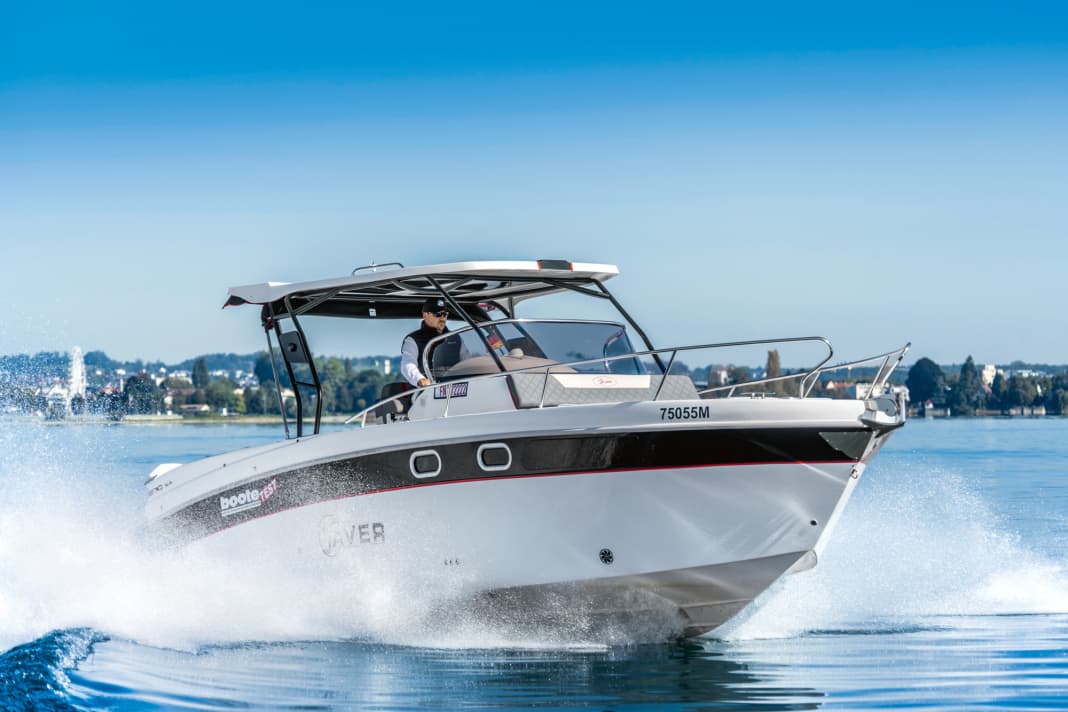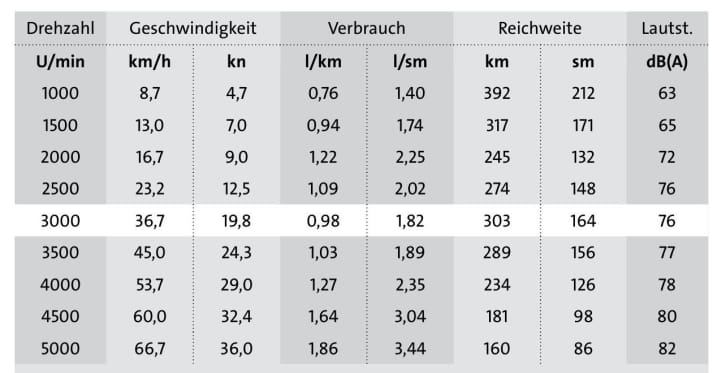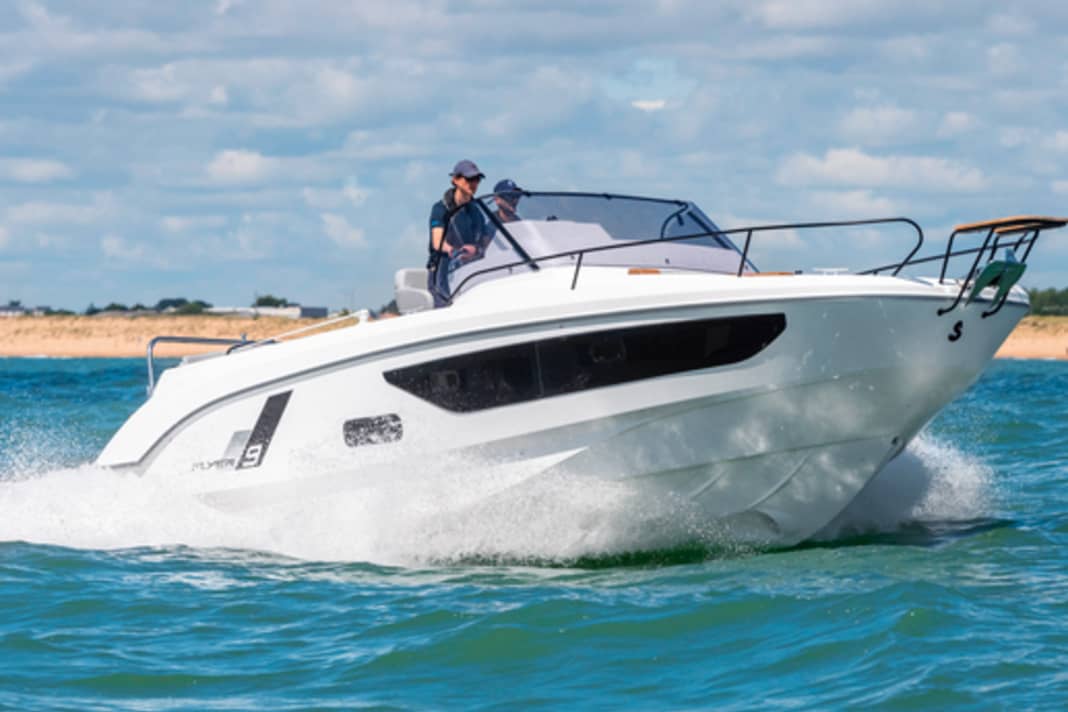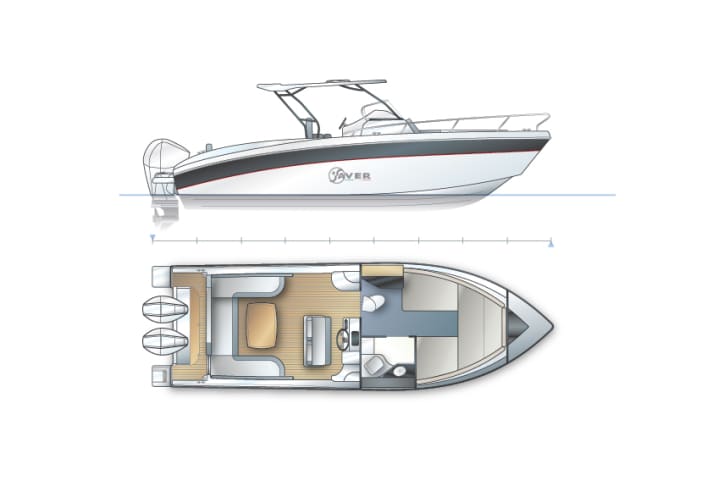





The Sicilian Saver shipyard has been producing in Piraino at the foot of Mount Etna since 1986. There are currently 15 models in four product lines in the range. The Saver 870 WA is positioned directly below the flagship of the walkaround series, the 330 WA, and was launched in 2018. We tested the new version with a layout adapted to its big sister with wide gangways on the foredeck, a new wet cell and the new hardtop, which was presented at Interboot 2022.
The open cockpit, for which a Bimini top with side panels is also available as a convertible top, keeps weather protection to a minimum. No problem for owners who are usually travelling in good weather or in southern climes. Thanks to the option of fitting twin systems, the boat is ideally suited for coastal use. A cabin with wet room also allows for longer trips with overnight stays. Those who occasionally practise board sports or want to pull inflatable fun toys will also be well served.
Boats in this category are usually pre-rigged by the shipyards but delivered to the dealer without an engine. For a Saver 870 WA, the basic equipment costs around 66,520 euros, plus the engines and assembly including some small parts at the dealer. In the case of the test boat, which is equipped with two Mercury F200 V6 DS engines, this results in a basic price of 119,520 euros. When it comes to trailering, you are at the limit. On the one hand, the width is a problem here, which requires a special licence, and on the other hand, the weight becomes a hurdle with double systems.
Measurement results

The design-related lack of a continuous bathing platform on outboards is a strikingly good solution, as the entire area in front of the engines can be accessed on the same level on the test boat. However, the folding GRP cover with its gas pressure damper is one of the options. The two platform extensions, folding centre cleats and a 12-volt socket are included in the Avantgarde equipment package alongside various upholstery extras or can be ordered separately. Despite the two engines in the rear, this provides a usable area for scuba diving or board sports.
The passageway with stern door on the starboard side leads to the cockpit, where a U-shaped upholstered seating area with table is fitted across the entire width. For an extra charge, the arrangement can be converted into a sunbathing area. In front of this is the console for the double bench seat of the helm station. The seats can be folded forwards to reveal a wet bar, which can also be equipped with a gas cooker or electric grill and a side-mounted refrigerator if required.
The control console offers sufficient space for additional accessories
In front of this is the control console with the engine instrumentation and sufficient space for mounting multifunction displays or other accessories. A compass is included as standard. Bow thruster, joystick control or a trim system are available on request. The electro-hydraulic steering system fitted in our test boat is recommended for twin-engine versions. Although the acrylic glass windscreen offers some protection, it cannot be fitted with windscreen wipers. The GRP top is an option, as is the boom with bimini top and side sections. Steps on both sides lead to the wide gangways to the sunbed or to the anchor locker on the foredeck. An electric anchor winch is optional, as is the anchor installation including chain. The walkway is well secured with solid handrails and the railing.
The acrylic sliding door at the helm opens up the companionway to the cabin area. A large V-shaped double berth in the bow awaits the crew here. The space is ventilated by hatches at the sides and a hatch in the foredeck, which also serves as an emergency exit. The permanently glued acrylic glass windows are an extra. There is a built-in cupboard to port in front of the berths. An additional refrigerator can be placed here. There is also a small work surface and an electrical panel with fuses right by the companionway.
Standing height is rather limited throughout the ship
The head compartment is located on the starboard side and contains an electric toilet as well as a washbasin with shower head fitting. However, you have to make do with a limited headroom of just 1.64 metres. The saloon still offers 1.77 metres. A further berth measuring 2.00 x 1.10 metres is located amidships, which can also be used as a double berth for smaller children. The room height is only 0.5 metres, a curtain serves as a partition. When the berth is not in use, accessories can also be stowed here.
The Saver 870 WA can be motorised with both single and twin systems from 221 kW (300 hp) to 298 kW (400 hp). If you want a Lake Constance licence, you can have two GP 150s with Lake Constance licence (BSO II) fitted. On the test boat, the maximum permissible motorisation is bolted in the form of two Mercury F200 V6 DS. It should be noted that the optimum propellers could not be procured due to supply bottlenecks and that only the lower end of the permissible speed range between 5000-5800 rpm could be achieved with the alternative fitted. Although this is economical when travelling, it does not achieve the possible peak values for speed or acceleration. The stable planing speed was reached after five seconds at 3000 rpm and 19.8 knots. The maximum speed of 36 knots was reached after 12 seconds. According to the dealer, speeds of over 40 knots are certainly achievable with the appropriate propellers.
Our test judgement
DRIVING & MANOEUVRING
+ Easy manoeuvring
+ Safe driving characteristics
PROCESSING & TECHNOLOGY
+ Professional installations
+ Good workmanship
SAFETY
+ Good movement safety
- No manual drain pump, missing fire extinguisher
COMFORT ON BOARD
+ Comfortable seating and reclining areas
+ Complete wet room
Competitors of the Saver 870 WA:




The optional 350-litre tank recommended for twin engines - 250 litres are standard - enables ranges of 164 nautical miles in the most efficient speed range after deducting the 15 percent reserve. This corresponds to a consumption of 36 litres per hour, which is a good value for the twin system. Despite the less than ideal propellers, the boat is a lot of fun to drive. Full circles at high speed are possible with only two boat lengths in diameter. When the steering is turned, the reaction is always uncritical. When manoeuvring in the harbour, a short reaction time can be noted. Immersion in waves is butter-soft, which promises good suitability for rough water. The mechanical and electrical installation of all components is cleanly executed and remains free of criticism. In terms of safety elements, a missing fire extinguisher and the lack of a manual bilge pump should be noted. However, two electric pumps are on board. A little more storage space would also be desirable.
Conclusion
The Saver 870 WA is ideal for coastal cruising in good weather conditions. The tested twin engine is perfectly adapted and provides a lot of driving pleasure with very good manoeuvrability. There are sun loungers in the cockpit or on the foredeck for relaxing.
Technical data of the Saver 870 WA
The boat
- Shipyard: Saver/I
- Type: 870 WA
- CE category: C/10 persons
- Hull and deck: Plastic
- Length over everything: 9,00 m
- Width: 2,72 m
- Displacement (without motors): 2000 kg
- Draught (without drive): 0,45 m
- Clearance height: 2,45 m.
- Fuel tank: 250 l, opt. 350 l
- Water tank: 100 l
- Holding tank: 100 l
- Cabins: 1
- Berths: 2+1
- Berth dimensions: Bow 237 x 1.98 m; underfloor 2.00 x 1.10 m
- Standing height/seating height: Cabin up to 1.77 m; washroom 1.64 m; under sunroof 1.95 m
- Cockpit size: 2.50 m x 2.16 m
- Turning circles (boat lengths): forwards tr. 1.5, bb. 1.5 backwards tr. 1.5, bb. 1.5
- Change from starboard to port: 1 s
- from Bb. to Stb: 1 s
- Sun lounger: Fore deck 2.00 m x 1.70 m
- Cockpit: 2.16 x 1.20 m
- Freeboard: 0,27 m
- Interior cockpit side height: 0,83 m
- Motorisation: Outboard engines, single or twin units from 221 kW (300 hp) to 298 kW (400 hp)
- Test motorisation: 2 x Mercury F200 V6 DS 149 kW (200 hp) each
- Price (standard boat with testm.): from € 119,520
- Distribution (test partner): www.bootscenter-menken.de
The motor
- Manufacturer: Mercury
- Type: F200 V6 DS
- Performance: 149 kW/200 hp
- Full load speed: 5000-5800 rpm
- Cylinder: V6
- cubic capacity: 3400 cc
- Fuel: Petrol
- Cooling: Water/single circle
- Generator: 12 V/85 A
- Dry weight: 216 kg
- Gear ratio: 1,85 : 1
- Test propeller: 14,7" x 19"

Standard equipment
4 cleats, bathing ladder, stainless steel railing, complete upholstery, fuel tank with level indicator and shut-off valve, water tank with pressure system, sink and shower, anchor roller, table in cockpit, deck hatch in cabin, two electric bilge pumps, compass, cabin lighting, LED night light in cockpit and cabin, instrument panel with switches, acrylic windscreen, hydraulic steering, acrylic cabin door, main battery switch, electric marine toilet with holding tank

